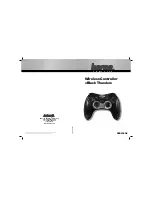
WARNINGS & SAFETY INSTRUCTIONS
Compact
cannot anticipate all of the situations a user may
encounter while installing and using the Compact II actuators.
The user must know and follow all applicable industry
specifications on the safe installation and use of these
actuators. Misapplication of the product may result in injuries
or property damage. Refer to
Compact
catalogue for
additional product safety information or contact Compact.
1.
Make sure the actuator is isolated from air supply or electrical
ancillaries before attempting to do any maintenance.
2.Before removing the actuator from a valve always make
sure the line has been depressurized and drained. Cycle the
valve a few times to relieve any pressure that could be trapped
in the body cavity.
3.
Utmost caution must be taken when handling the
actuator. Only qualified personal are who are trained for
maintenance work and have read the instructions are
t o a s s e m b l e o r d i s a s s e m b l e t h e a c t u a t o r.
4.
Before operating an actuator which is connected to a valve
in the pipeline make sure you know the valve function.
5. Use only Compact II components and spare parts
supplied in the Repair Kits.
6.
Do not attempt to remove the actuator pistons by use
of air pressure when the covers have been removed.
7.
Do not leave any grip key or shaft connection attached
to the actuator, or try to manually operate the actuator
while it is still connected to the air pressure.
8. Use the actuator within the pressure and temperature
limits indicated on the nameplate or as given in our
GENERAL
This Installation, Operating & Maintenance manual covers the
instructions required for safe use of the Compact II pneumatic
actuator. Before using the actuator, read the entire IOM and
make sure you understand everything.
Installation, Operating & Maintenance instructions
PAGE 2
Supply Pressure
The supply pressure for the Compact II actuators are as
follows:
Double-acting: 2-8 barg (30-120 psig).
Spring-return: 3-8 barg (40-120 psig).
Spring-return actuators can also operate with air pressure
of 2 barg (30 psig) by using the appropriate spring
configuration as shown in the Compact catalogue. When
sizing an actuator to available air supply, make sure you
have adequate power in the actuator to allow the valve to
complete its operation and leave enough power for safety
margin.
STORAGE
The Compact actuator has been packaged to provide
protection during shipment, however, it can be damaged in
transport.
Prior to storage, inspect the actuator for shipping
damage. Keep the actuators in their original packing box
during storage. It is recommended to keep the actuators in
a clean and dry environment until ready for use. The actuator
has two air ports, which should be plugged during storage
to prevent liquids or other materials from entering the actuator
during storage. If the actuators are to be stored for a long
period of time before installation, it is recommended to
stroke them periodically to prevent setting of the seals. Store
the actuators indoors to protect them from humidity and
dust.
Air Supply
Use clean dry air. Other inert gases may be used such as
nitrogen, argon and natural gas. Thin hydraulic oil can also
be used. Do not use water as supply media.
Oxygen or
hydrogen must NOT BE USED.
The operating medium is to be filtered to 30 micron particle
size or less. Always consult with a representative of Compact
for suitability and recommended practice.
Piping connected to the actuator or accessories should be
fitted according to recommended instrumentation piping
practice. Prior to connection make sure all lines have no
loops and are free of water, oil or other contaminants that
may be trapped in the pipes. Pipes must be flushed with air
to clean the passages. Where sealants are been used for
threaded connections, care must be taken to avoid excess
m a t e r i a l b e e n f o rc e d i n t o t h e a c t u a t o r p o r t s .
OPERATING CONDITIONS
Lubricants
The actuators come lubricated from the factory and under
normal operating conditions do not require re-lubrication. In
the event of actuator maintenance it is recommended to use
the following lubricants:
For NBR O-rings use EP1.
The lubricant is suitable for use from -20
°
C (-4
°
F) to +80
°
C
(+176
°
F).
For Viton O-rings use Molykote 111 or OKS 1110.
The lubricants are suitable for use from -40
°
C (-40
°
F) to
+140
°
C (+284
°
F).
For EPDM O-rings use only Silicone grease (i.e. Molykote
111 or OKS 110).
The lubricants are suitable for use from -40
°
C (-40
°
F) to
+140
°
C (+284
°
F).
Explosive Environment
The Compact II can be installed in any appropriate potentially
explosive hazardous area as listed on the identification
nameplate on the actuator. The Compact II is certified to
category II according to the ATEX Directive 94/9/EC
(Equipment intended for use in Potentially Explosive
Atmospheres).
For applications requiring category I protection please consult
with Compact representative .






























